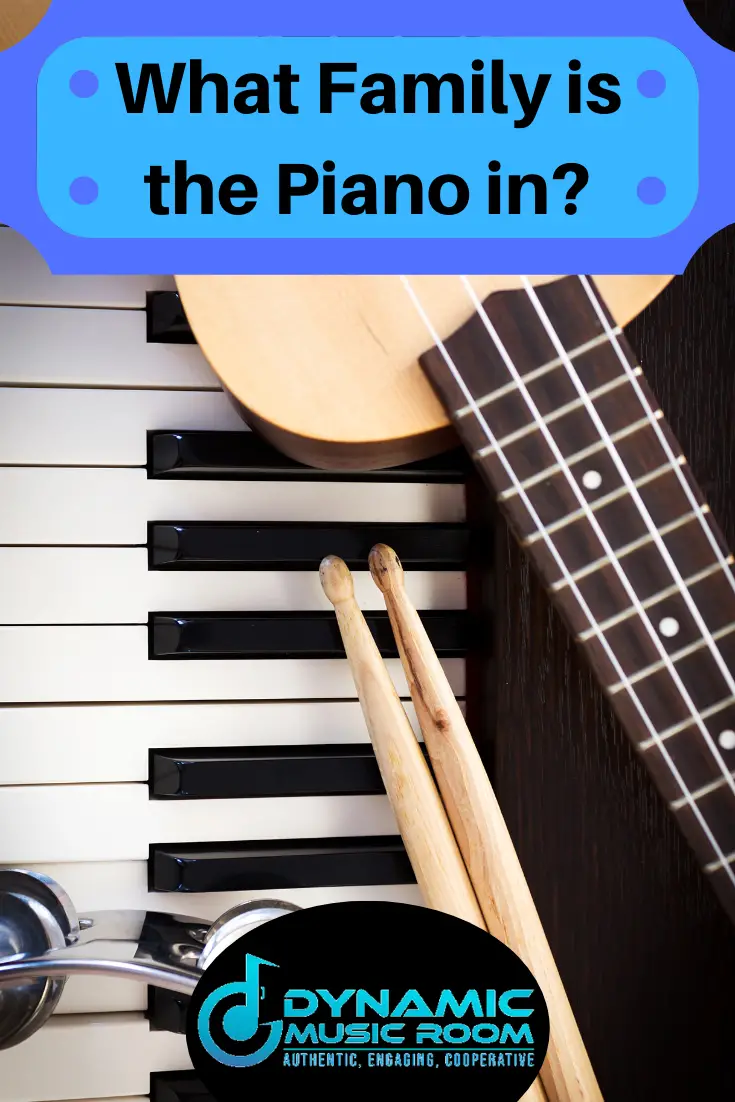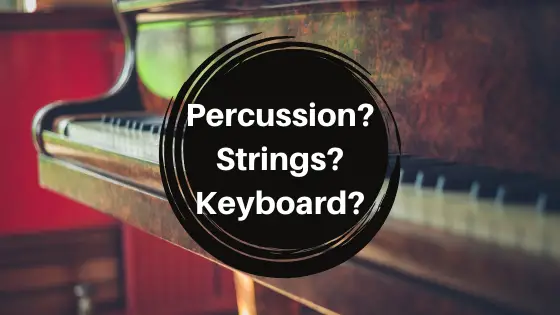When we talk about instruments, I’m always asked about where the piano belongs.
It’s kind of a tricky question and one hotly debated by musicians of all levels.
I did some research into the different arguments and ideas, so I could better answer for my students:
What family is the piano in?
The piano is considered to be part of the percussion, string, and keyboard family all at the same time. Strong arguments are possible for any of these three families, and it’s important to know why.
Look ahead as we dig into the details.
Table of Contents
What Makes An Instrument Family?
First, you need to know what makes an instrument part of a specific family.
Most people incorrectly assume it’s based on what the instrument is made of or looks like.
This assumption leads to some embarrassing moments in the music world. Even publishers will make posters or content with the flat-out wrong information.
Although, this does lead to some good discussion with my students on why they’re wrong.
Instruments are sorted into families by how they create their sound.
It has nothing to do with how they look, although the names are drawn in some ways from how they look.
Here are the main instrument families and what it takes to be part of the family:
- Brass* = Buzzing lips into a tube
- Woodwind = Vibrate a reed or split the air
- Strings = Pluck, strum, strike, or draw a bow across strings
- Percussion = Hit, shake, or scrape (rub together) anything
*The brass family is the most confusing. The material doesn’t matter; if you buzz, it’s part of the brass family.
There are some who would add another family into this, the keyboard family. But there are many musicians who don’t consider this a true instrument family.
We’ll dig into this in the next section.
Learn about when to start piano lessons.

What Family Of Instruments Does The Piano Belong To?
With a better understanding of what makes an instrument belong to a family, we can dive into the debate and see why some argue one way or the other.
Strings
One group argues the piano is a member of the string family.
Inside every piano are two strings per key. Most standard-sizes pianos have 88 keys which means 176 strings.
When you press the key, a small felt hammer strikes the strings creating the classic piano sound.
Those who believe the piano is a string instrument argue the source of vibration from the instrument comes from the strings. This makes it strongly a member of the string family.
Percussion
Another vocal group is the one arguing the piano is a member of the percussion family.
As we mentioned above, to be considered a percussion instrument, you must hit, shake, or scrape (rub together) the instrument.
In this way, the percussion family lays claim to many instruments which are non-traditional. It’s not uncommon to use different sized vehicle brakes (yes, the kind that stops your car) as an instrument.
Because when you press the key, it’s a hammer hitting the strings, percussion advocates argue the method of play is more like the percussion family.
Interested in donating a piano as you get a new one? Check out these places in our article at the link.
Keyboard Family
The final group is a little smaller than the other two. These people argue the piano is part of a different family altogether called the keyboard family.
This family includes any instrument played by the method of pressing down keys. This would then include digital pianos, celeste, harpsichords, and organs.
Some argue this family isn’t entirely legitimate as the focus is on how the instrument creates sound rather than what method the instrument is played with.
According to the people, organs are a woodwind instrument because they create sounds by pushing air through pipes. The electronic keyboard or piano would be a member of the electric family of instruments.
Those who support the keyboard family argue the technique used in playing all these are so similar, the instruments belong together in a separate group.
Interestingly, in my experience, piano players strongly support this argument while other musicians tend to favor one of the two from above.
Check out hints for how to memorize the piano keys.
What’s My Opinion?
What’s the answer? What do I think?
It doesn’t really matter.
Most importantly, you and your students know why people argue each family is an option. The debate alone allows you to engage in serious higher order reasoning and debate skills.
As I was typing this article up, I asked my wife (also a music teacher though she focuses on band) what she thinks.
Her answer was a combination of percussion and strings with a slight edge towards percussion. She didn’t recognize the keyboard family as a true separate family.
Then she forced me to choose.
If I had to pick one, I’d say the keyboard family. Yes, the way you create the sound is important and the way we split up most instruments, but the technical playing stays true across so many keyboard instruments, I feel it’s better to associate them on their own.
At the end of the day, we didn’t get upset by this and neither should you. It’s more important in life to be able to make a conclusion and back up your reasoning.
Conclusion
Now you know a little more about what family the piano is in. Whether you say string family, percussion family, or keyboard family, the instrument is once of the most iconic in the music world.
Ultimately, it’s up to you what you consider it to be a part of. But if you’re a teacher, this is a great jumping point for a debate and discussion with your students to reach some higher order thinking skills.
Interested in improving your piano skills? Check out Flowkey for free to access courses, practice tools, and over 1,500 songs of all playing levels.
This is an affiliate link which means I earn a small commission if you end up buying the premium (but affordable) plan. But seriously, this program is awesome; you should check it out for free too.

